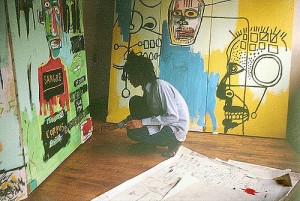Basquiat’s career is interesting in the context of graffiti art, because, strictly speaking, he never really fit the bill. He would not have considered himself a graffiti artist, nor was he thought of as one by other Graffiti artists. Yet the art establishment consistently situates Basquiat within this milieu, where his “reported relations to graffiti culture were cursory at best, but early and brief associations were extrapolated into the false legend of an artist ‘who misspent his youth spraying graffiti on subway trains’” (Saggese, 5).
Indeed, part of Basquiat’s appeal in the mainstream art market revolved around the presumed ‘primitive’ nature of his art work. He was never classically trained and, as such, his work was positioned at a curious intersection between graffiti art and the primitive, where his “ quick brushstrokes, jagged lines, rough textures, and seemingly chaotic compositions of his canvases speak directly to the stereotype” (Saggese, 5).
Basquiat emerged as a figure in the art world at a time when Wall Street was booming. There was an enormous amount of capital circulating in New York, and the contemporary art scene became increasingly linked with commerce. Like many of his colleagues, Basquiat was out to make a name for himself; to monetize his art. In spite of his class, Basquiat was rendered an outsider as a result of his race; moreover, he was fetishized because of it—his peripheral status made him marketable. It also ensured that his oeuvre was positioned within the corpus of graffiti art, which was also seen as a peripheral phenomenon. While many of the graffiti artists who emerged in the late 1970s saw their star diminish by the mid to late eighties, where they served as a cursory fad in the marketplace, Basquiat’s work would continue to grow in its notoriety.

